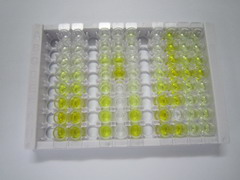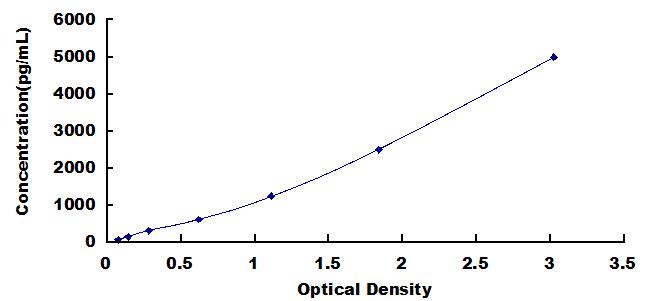Packages (Simulation)

Reagent Preparation

Image (I)
Image (II)
Certificate


ELISA Kit for Synuclein Alpha (SNCa)
SNC-A; aSYN; PD1; PARK1; PARK4; NACP; Non-A Beta Component Of Alzheimer's Disease Amyloid Precursor Protein; Non-A4 component of amyloid precursor
- Product No.SEB222Mu
- Organism SpeciesMus musculus (Mouse) Same name, Different species.
- Sample TypeSerum, plasma, tissue homogenates, cell lysates, cell culture supernates and other biological fluids
- Test MethodDouble-antibody Sandwich
- Assay Length3h
- Detection Range78-5,000pg/mL
- SensitivityThe minimum detectable dose of this kit is typically less than 30pg/mL.
- DownloadInstruction Manual
- UOM 48T96T 96T*5 96T*10 96T*100
- FOB
US$ 479
US$ 684
US$ 3078
US$ 5814
US$ 47880
For more details, please contact local distributors!
Specificity
This assay has high sensitivity and excellent specificity for detection of Synuclein Alpha (SNCa).
No significant cross-reactivity or interference between Synuclein Alpha (SNCa) and analogues was observed.
Recovery
Matrices listed below were spiked with certain level of recombinant Synuclein Alpha (SNCa) and the recovery rates were calculated by comparing the measured value to the expected amount of Synuclein Alpha (SNCa) in samples.
| Matrix | Recovery range (%) | Average(%) |
| serum(n=5) | 95-104 | 101 |
| EDTA plasma(n=5) | 87-96 | 90 |
| heparin plasma(n=5) | 86-105 | 98 |
Precision
Intra-assay Precision (Precision within an assay): 3 samples with low, middle and high level Synuclein Alpha (SNCa) were tested 20 times on one plate, respectively.
Inter-assay Precision (Precision between assays): 3 samples with low, middle and high level Synuclein Alpha (SNCa) were tested on 3 different plates, 8 replicates in each plate.
CV(%) = SD/meanX100
Intra-Assay: CV<10%
Inter-Assay: CV<12%
Linearity
The linearity of the kit was assayed by testing samples spiked with appropriate concentration of Synuclein Alpha (SNCa) and their serial dilutions. The results were demonstrated by the percentage of calculated concentration to the expected.
| Sample | 1:2 | 1:4 | 1:8 | 1:16 |
| serum(n=5) | 78-103% | 78-101% | 97-105% | 91-99% |
| EDTA plasma(n=5) | 97-105% | 86-104% | 90-97% | 89-103% |
| heparin plasma(n=5) | 86-102% | 91-104% | 95-102% | 78-97% |
Stability
The stability of kit is determined by the loss rate of activity. The loss rate of this kit is less than 5% within the expiration date under appropriate storage condition.
To minimize extra influence on the performance, operation procedures and lab conditions, especially room temperature, air humidity, incubator temperature should be strictly controlled. It is also strongly suggested that the whole assay is performed by the same operator from the beginning to the end.
Reagents and materials provided
| Reagents | Quantity | Reagents | Quantity |
| Pre-coated, ready to use 96-well strip plate | 1 | Plate sealer for 96 wells | 4 |
| Standard | 2 | Standard Diluent | 1×20mL |
| Detection Reagent A | 1×120µL | Assay Diluent A | 1×12mL |
| Detection Reagent B | 1×120µL | Assay Diluent B | 1×12mL |
| TMB Substrate | 1×9mL | Stop Solution | 1×6mL |
| Wash Buffer (30 × concentrate) | 1×20mL | Instruction manual | 1 |
Assay procedure summary
1. Prepare all reagents, samples and standards;
2. Add 100µL standard or sample to each well. Incubate 1 hours at 37°C;
3. Aspirate and add 100µL prepared Detection Reagent A. Incubate 1 hour at 37°C;
4. Aspirate and wash 3 times;
5. Add 100µL prepared Detection Reagent B. Incubate 30 minutes at 37°C;
6. Aspirate and wash 5 times;
7. Add 90µL Substrate Solution. Incubate 10-20 minutes at 37°C;
8. Add 50µL Stop Solution. Read at 450nm immediately.
GIVEAWAYS
INCREMENT SERVICES
-
 Single-component Reagents of Assay Kit
Single-component Reagents of Assay Kit
-
 Lysis Buffer Specific for ELISA / CLIA
Lysis Buffer Specific for ELISA / CLIA
-
 Quality Control of Kit
Quality Control of Kit
-
 ELISA Kit Customized Service
ELISA Kit Customized Service
-
 Disease Model Customized Service
Disease Model Customized Service
-
 Serums Customized Service
Serums Customized Service
-
 TGFB1 Activation Reagent
TGFB1 Activation Reagent
-
 Real Time PCR Experimental Service
Real Time PCR Experimental Service
-
 Streptavidin
Streptavidin
-
 Fast blue Protein Stain solution
Fast blue Protein Stain solution
-
 Single-component Reagents of FLIA Kit
Single-component Reagents of FLIA Kit
-
 Streptavidin-Agarose Beads
Streptavidin-Agarose Beads
| Magazine | Citations |
| The Journal of Clinical Investigation | Cerebrospinal fluid–based kinetic biomarkers of axonal transport in monitoring neurodegeneration PubMed: PMC3428100 |
| Neurobiology of Disease | Lysosomal dysfunction increases exosome-mediated alpha-synuclein release and transmission PubMed: PMC3107939 |
| Nature Communications | Parkinson's disease induced pluripotent stem cells with triplication of the α-synuclein locus PubMed: PMC3265381 |
| Provisional chapter | Mutations of PARK Genes and Alpha-Synuclein and Parkin Concentrations in Parkinson’s Disease Intechopen:Source |
| Nerodegeneration | Apolipoprotein Eε4: A Biomarker for Executive Dysfunction among Parkinson's Disease Patients with Mild Cognitive Impairment pubmed:29326545 |
| Experimental gerontology | The anti-aging protein klotho alleviates injury of nigrostriatal dopaminergic pathway in 6-hydroxydopamine rat model of Parkinson's disease: Involvement of PKA/CaMKII/CREB signaling. pubmed:29107062 |
| Neurobiology of Disease | Development and biochemical characterization of a mouse model of Parkinson's disease bearing defective glucocerebrosidase activity Pubmed: 30521842 |
| molecular and cellular biochemistry | Potential therapeutic effects of antagonizing adenosine A2A receptor, curcumin and niacin in rotenone-induced Parkinson's disease mice model Pubmed: 31820278 |
| International Journal of Pharmacology | Nose to brain delivery of rotigotine loaded chitosan nanoparticles in human SH-SY5Y neuroblastoma cells and animal model of Parkinson's disease Pubmed: 32084576 |
| EBioMedicine | Anti-α-synuclein ASO delivered to monoamine neurons prevents α-synuclein accumulation in a Parkinson's disease-like mouse model and in monkeys Pubmed: 32810825 |
| Catalog No. | Related products for research use of Mus musculus (Mouse) Organism species | Applications (RESEARCH USE ONLY!) |
| RPB222Mu01 | Recombinant Synuclein Alpha (SNCa) | Positive Control; Immunogen; SDS-PAGE; WB. |
| RPB222Mu02 | Recombinant Synuclein Alpha (SNCa) | Positive Control; Immunogen; SDS-PAGE; WB. |
| PAB222Mu02 | Polyclonal Antibody to Synuclein Alpha (SNCa) | WB; IHC; ICC; IP. |
| PAB222Mu01 | Polyclonal Antibody to Synuclein Alpha (SNCa) | WB; ICC/IF |
| MAB222Mu21 | Monoclonal Antibody to Synuclein Alpha (SNCa) | WB |
| SEB222Mu | ELISA Kit for Synuclein Alpha (SNCa) | Enzyme-linked immunosorbent assay for Antigen Detection. |
| MEB222Mu | Mini Samples ELISA Kit for Synuclein Alpha (SNCa) | Enzyme-linked immunosorbent assay for Antigen Detection. |
| LMB222Mu | Multiplex Assay Kit for Synuclein Alpha (SNCa) ,etc. by FLIA (Flow Luminescence Immunoassay) | FLIA Kit for Antigen Detection. |
| KSB222Mu01 | ELISA Kit DIY Materials for Synuclein Alpha (SNCa) | Main materials for "Do It (ELISA Kit) Yourself". |






